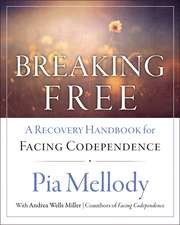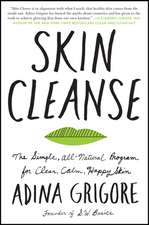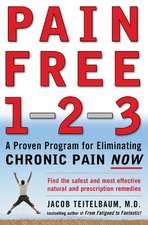Foods That Fight Pain: Revolutionary New Strategies for Maximum Pain Relief
Autor Neal D. Barnarden Limba Engleză Paperback – 31 mar 1999
Drawing on new and little-known research from prestigious medical centers around the world, Neal Barnard, M.D., author of Eat Right, Live Longer and Food for Life, shows readers how they can soothe everyday ailments and cure chronic pain by using common foods, traditional supplements, and herbs.
Dr. Barnard reveals which foods regularly contribute to pain and how to avoid them. He guides the reader to specific pain-safe foods that are high in nutrition but don't upset the body's natural balance, as well as foods that actively soothe pain by improving blood circulation, relieving inflammation, and balancing hormones. Complete with delicious recipes, Foods That Fight Pain is a revolutionary approach to healing that will transform your life.
Preț: 124.93 lei
Nou
Puncte Express: 187
Preț estimativ în valută:
23.91€ • 25.96$ • 20.08£
23.91€ • 25.96$ • 20.08£
Carte disponibilă
Livrare economică 02-16 aprilie
Preluare comenzi: 021 569.72.76
Specificații
ISBN-13: 9780609804360
ISBN-10: 0609804367
Pagini: 368
Dimensiuni: 156 x 231 x 25 mm
Greutate: 0.52 kg
Ediția:Pbk.
Editura: HARMONY
ISBN-10: 0609804367
Pagini: 368
Dimensiuni: 156 x 231 x 25 mm
Greutate: 0.52 kg
Ediția:Pbk.
Editura: HARMONY
Recenzii
"Dr. Neal Barnard is one of the most responsible and authoritative voices in American medicine today." ----Andrew Weil, M.D., author of 8 Weeks to Optimal Health and Spontaneous Healing
Notă biografică
Neal Barnard, M.D., is president of the Physicians' Committee for Responsible Medicine, editor-in-chief of the newsletter Good Medicine, and a member of the advisory board of Vegetarian Times magazine. Dr. Barnard travels widely giving lectures on nutrition and health.
Extras
We all suffer pain from time to time, and for some of us that pain has become a recurring, and sometimes constant, presence in our lives. In this book I would like to offer you an approach to pain that is different--and perhaps more powerful--than anything you have ever tried. It is based on the premise that foods have medicinal value, a notion which has long been accepted in the medical traditions of China, India, Native America, and other cultures around the world, and is now being confirmed by the latest Western medical research.
Foods can fight pain. In the pages ahead, we'll discuss how this works, and specifically which foods or supplements will be most effective for your pain, along with recipes for turning those foods into delicious meals. But for the moment I want to establish something important: There is nothing speculative or far-out about the premise that foods can fight pain. On the contrary. The ideas presented in this book are drawn from a wealth of new research from prestigious medical centers around the world.
Years ago, findings showing that foods work against pain, even pain in its most severe forms, emerged as tentative and sometimes controversial theories. Physicians and scientists then rigorously investigated these concepts in human research volunteers. Today, after years of testing, discarding, and refining, we arrived at a revolutionary way of thinking about pain. Research studies have given us the scientific basis, not only for why foods work this magic, but also how to put it to use. This book translates these powerful new laboratory findings into simple steps that you can use.
Nutrients work against pain in four ways. They can reduce damage at the site of injury, cool your body's inflammatory response, provide analgesia on pain nerves themselves, and even work within the brain to reduce pain sensitivity.
The most important approach for you depends on the kind of pain you have. If you have arthritis, your goal is to stop the joint damage along with the pain. If you have cancer pain or chest pain, you can choose foods to affect the disease process itself. If you have shingles, diabetic nerve pains, or carpal tunnel syndrome, you need to fix a problem within the nerves. If you have a chronic backache, headaches, abdominal pain, or cramps, you just want the pain to disappear. Specific foods can help with all of these.
Different Foods for Different Kinds of Pain
Research studies have revealed special effects of certain foods and nutrients, as we will see in detail in the chapters that follow. Rice or peppermint oil, for example, can soothe your digestive tract. Ginger and the herb feverfew can prevent migraines, and coffee sometimes cures them. Natural plant oils can reduce arthritis pain. Cranberry juice can fight the pain of bladder infections. Vitamin B6 can even increase your pain resistance, to name just a few.
Whether we are talking about back pain, migraines, cancer pain, or anything else, there are three basic principles to using foods to fight pain. I will spell them out briefly here and, in the chapters that follow, will show you how to apply them.
Choose pain-safe foods. In headaches, joint pains, and digestive pains, for example, the key is not so much in adding new foods as in finding out which foods have caused your pain and avoiding them, while building your meals from foods that virtually never cause symptoms for anyone.
In the Lancet of October 12, 1991, arthritis researchers announced the results of a carefully controlled study that tested how avoiding certain foods could reduce inflammation. Often the culprits were as seemingly innocent as a glass of milk, a tomato, wheat bread, or eggs. By avoiding specific foods, many patients improved dramatically: pain diminished or went away, and joint stiffness was no longer the routine morning misery. The same benefit has been seen for migraines. While there are also benefits to be gained from certain supplements, particularly natural anti-inflammatory plant oils, identifying your own sensitivities is an enormously important first step.
Sugar may affect pain, at least in certain circumstances. As we will see in chapter 12, researchers at the Veterans Administration Medical Center in Minneapolis tested its effects on a group of young men. They attached a clip to the web of skin between their fingers, and wired the clip to an electrical stimulator. They gradually increased the voltage, and asked the men to say when they felt any pain and at what point they found it intolerable. As the researchers then infused a dose of sugar, the volunteers found that they could feel the pain sooner and felt it more intensely. The researchers then tested diabetics, who tend to have more sugar in their blood than other people, and found that they too were more sensitive to pain than other people.
What would it mean if some part of your diet, whether it was sugar or anything else, were to cause pain to hurt just a bit extra, without your realizing what was causing this problem? In fact, there are many foods that trigger pain and aggravate inflammation. Choosing pain-safe foods is as important as bringing the special healing foods in.
Add soothing foods that ease your pain. Foods that improve blood flow are of obvious importance in angina, back pain, and leg pains. Foods that relieve inflammation help your joints to cool down. Other foods balance hormones and will come to your rescue if you have menstrual pain, endometriosis, fibroids, or breast pain. Hormone-adjusting foods have also been the subject of a considerable amount of research in cancer, as we will see.
Use supplements if you need them. I encourage you to explore the benefits of herbs, extracts, and vitamins that can treat painful conditions. Some have been in use for a very long time and have been tested in good research studies, as we will see. Do this under your doctor's care, so that a nutritional approach can be integrated with other medical measures as needed, and so that you have a solid diagnosis.
Foods can fight pain. In the pages ahead, we'll discuss how this works, and specifically which foods or supplements will be most effective for your pain, along with recipes for turning those foods into delicious meals. But for the moment I want to establish something important: There is nothing speculative or far-out about the premise that foods can fight pain. On the contrary. The ideas presented in this book are drawn from a wealth of new research from prestigious medical centers around the world.
Years ago, findings showing that foods work against pain, even pain in its most severe forms, emerged as tentative and sometimes controversial theories. Physicians and scientists then rigorously investigated these concepts in human research volunteers. Today, after years of testing, discarding, and refining, we arrived at a revolutionary way of thinking about pain. Research studies have given us the scientific basis, not only for why foods work this magic, but also how to put it to use. This book translates these powerful new laboratory findings into simple steps that you can use.
Nutrients work against pain in four ways. They can reduce damage at the site of injury, cool your body's inflammatory response, provide analgesia on pain nerves themselves, and even work within the brain to reduce pain sensitivity.
The most important approach for you depends on the kind of pain you have. If you have arthritis, your goal is to stop the joint damage along with the pain. If you have cancer pain or chest pain, you can choose foods to affect the disease process itself. If you have shingles, diabetic nerve pains, or carpal tunnel syndrome, you need to fix a problem within the nerves. If you have a chronic backache, headaches, abdominal pain, or cramps, you just want the pain to disappear. Specific foods can help with all of these.
Different Foods for Different Kinds of Pain
Research studies have revealed special effects of certain foods and nutrients, as we will see in detail in the chapters that follow. Rice or peppermint oil, for example, can soothe your digestive tract. Ginger and the herb feverfew can prevent migraines, and coffee sometimes cures them. Natural plant oils can reduce arthritis pain. Cranberry juice can fight the pain of bladder infections. Vitamin B6 can even increase your pain resistance, to name just a few.
Whether we are talking about back pain, migraines, cancer pain, or anything else, there are three basic principles to using foods to fight pain. I will spell them out briefly here and, in the chapters that follow, will show you how to apply them.
Choose pain-safe foods. In headaches, joint pains, and digestive pains, for example, the key is not so much in adding new foods as in finding out which foods have caused your pain and avoiding them, while building your meals from foods that virtually never cause symptoms for anyone.
In the Lancet of October 12, 1991, arthritis researchers announced the results of a carefully controlled study that tested how avoiding certain foods could reduce inflammation. Often the culprits were as seemingly innocent as a glass of milk, a tomato, wheat bread, or eggs. By avoiding specific foods, many patients improved dramatically: pain diminished or went away, and joint stiffness was no longer the routine morning misery. The same benefit has been seen for migraines. While there are also benefits to be gained from certain supplements, particularly natural anti-inflammatory plant oils, identifying your own sensitivities is an enormously important first step.
Sugar may affect pain, at least in certain circumstances. As we will see in chapter 12, researchers at the Veterans Administration Medical Center in Minneapolis tested its effects on a group of young men. They attached a clip to the web of skin between their fingers, and wired the clip to an electrical stimulator. They gradually increased the voltage, and asked the men to say when they felt any pain and at what point they found it intolerable. As the researchers then infused a dose of sugar, the volunteers found that they could feel the pain sooner and felt it more intensely. The researchers then tested diabetics, who tend to have more sugar in their blood than other people, and found that they too were more sensitive to pain than other people.
What would it mean if some part of your diet, whether it was sugar or anything else, were to cause pain to hurt just a bit extra, without your realizing what was causing this problem? In fact, there are many foods that trigger pain and aggravate inflammation. Choosing pain-safe foods is as important as bringing the special healing foods in.
Add soothing foods that ease your pain. Foods that improve blood flow are of obvious importance in angina, back pain, and leg pains. Foods that relieve inflammation help your joints to cool down. Other foods balance hormones and will come to your rescue if you have menstrual pain, endometriosis, fibroids, or breast pain. Hormone-adjusting foods have also been the subject of a considerable amount of research in cancer, as we will see.
Use supplements if you need them. I encourage you to explore the benefits of herbs, extracts, and vitamins that can treat painful conditions. Some have been in use for a very long time and have been tested in good research studies, as we will see. Do this under your doctor's care, so that a nutritional approach can be integrated with other medical measures as needed, and so that you have a solid diagnosis.
Descriere
One of America's most knowledgeable and trusted experts on nutrition shows readers how to soothe everyday ailments and cure chronic pain by using common foods, traditional supplements, and herbs.











